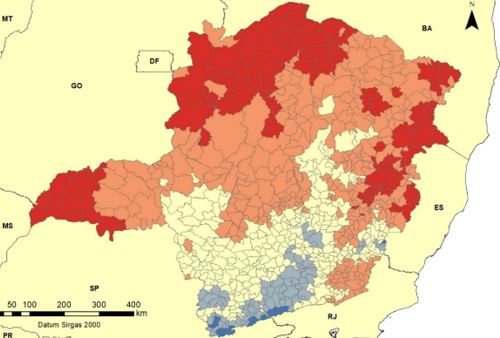Climate classification for Minas Gerais State according to the Holdridge life zones
DOI:
https://doi.org/10.20873/jbb.uft.cemaf.v7n2.ferreiraKeywords:
climate, biotemperature, rainfallAbstract
The climate exerts a notable influence on the processes of the planet, whether in the daily life of people, in the distribution of plant and animal species or in agroforestry activities. Numerous classifications were proposed to determine the climate of a region. In 1947, Holdridge proposed the life zones classification using biotemperature, rainfall, altitude and latitude data. Thus, the aim of this work was to classify the state of Minas Gerais according to the Holdridge life zones, as well as compare it with Köppen’s climate classification and the distribution of vegetation in the state. For this, a historical series of 25 years meteorological records data were used, in addition to the classification of Köppen and the vegetation classes of the state. Nine life zones were found and the most representative were premontane tropical moist forest (45.1%), subtropical moist forest (19.1%) and premontane tropical dry forest (10.8%). When comparing the Köppen’s climate classification and Holdridge life zones, it was found that the classifications that obtained the highest value relation to premontane tropical moist forest were Cwa (58.2%) and Cwb (50.3%). In comparison with the vegetation classes it was verified that premontane tropical moist forest had a greater relation with savanna (67.3%) and savanna/seasonal forest (72.3%). Based on the results obtained, it was observed that Holdridge life zones showed a good relation in the comparisons with Köppen and the vegetation map and is therefore suitable for classification of the state of Minas Gerais.
References
ALVARES, C.A.; STAPE, J.L.; SENTELHAS, P.C.; GON-ÇALVES, J.L.M.; SPAROVEK, G. Köppen’s climate clas-sification map for Brazil. Meteorologische Zeitschrift, v. 22, n. 6, p. 711 – 728, 2013. https://doi.org/10.1127/0941-2948/2013/0507
AYOADE, J.O. Introdução à climatologia para os trópicos. 14. ed. Rio de Janeiro: Bertrand Brasil, 2010. 350 p.
CARVALHO, L.G.; OLIVEIRA, M.S.; ALVES, M.C.; VIANELLO, R.L.; SEDIYAMA, G.C.; CASTRO NETO, P.; DANTAS, A.A.A. Clima. In: Scolforo, J.R.S.; Oliveira, A.D.; Carvalho, L.M.T. Zoneamento ecológico-econômico do estado de Minas Gerais: componentes geofísico e biótico. Lavras: Editora UFLA, 2008. p.89–101.
ELOI, C.M.A. Enquadramento das ‘zonas de vida’ de Holdri-dge na classificação climática de Minas Gerais. Ano de ob-tenção: 2001. 71p. Tese (Magister Scientiae) – Universidade Federal de Viçosa, Viçosa.
HINCAPIÉ, J.C.A.; CAICEDO, J.D.P. El cambio climático y la distribución espacial de las formaciones vegetales em Co-lombia. Colombia Forestal, Bogotá, v.16, n.2, p.171-185, 2013.
HOLDRIDGE, L.R. Life zone ecology. San José, Costa Rica: Tropical Science Center, 1967. 124p.
HOLDRIDGE, L.R. Ecologia basada em zonas de vida. San José, Costa Rica: Instituto Interamericano de Cooperación para la Agricultura, 2000.
INDÚSTRIA BRASILEIRA DE ÁRVORES (IBA). Relató-rio 2017. São Paulo, 2017. 80p.
INSTITUTO BRASILEIRO DE GEOGRAFIA E ESTA-TÍSTICA (IBGE). Shape de vegetação. 2006. Disponível em: <ftp://geoftp.ibge.gov.br/mapas_tematicos/mapas_murais/shapes/vegetacao/>. Acesso em: 20 mar. 2016.
INSTITUTO BRASILEIRO DE GEOGRAFIA E ESTA-TÍSTICA (IBGE). Anuário estatístico do Brasil. Rio de Ja-neiro, v. 71, 2011. 474p.
INSTITUTO BRASILEIRO DE GEOGRAFIA E ESTA-TÍSTICA (IBGE). Manuais técnicos em geociências: manu-al técnico de vegetação brasileira. Rio de Janeiro, 2. ed., 2012. 171p.
INSTITUTO BRASILEIRO DE GEOGRAFIA E ESTA-TÍSTICA (IBGE). Área da unidade territorial. Rio de Janei-ro: IBGE, 2017. Disponível em: <https://cidades.ibge.gov.br/brasil/mg>. Acesso em: 24 mar. 2018.
MILANO, M.S.; BRASSIOLO, M.M.; SOARES, R.V. Zoneamento ecológico experimental do estado do Paraná segundo o sistema de zonas de vida de Holdridge. Floresta, Curitiba, v.17, n.12, p.65-72, 1987. http://dx.doi.org/10.5380/rf.v17i12.6371
NOGUEIRA, A.C.; KUNIYOSHI, Y.S.; SOARES, R.V. Zonas de vida para o estado de Santa Catarina segundo a classificação das formações vegetais de Holdridge. Floresta, Curitiba, v.17, n.12, p. 103-112, 1987. http://dx.doi.org/10.5380/rf.v17i12.6372
REBOITA, M.; RODRIGUES, M.; SILVA, L.; ALVES, M. Aspectos climáticos do estado de Minas Gerais. Revista Brasileira de Climatologia, v.17, p.206-226, 2015. http://dx.doi.org/10.5380/abclima.v17i0.41493
SAWYER JÚNIOR, J.O.; LINDSEY, A.A. The Holdridge bioclimatic formations of eastern and central United States. Proceedings of the Indiana Academy of Science, n.73, p.105-112, 1964.
SOARES, R.V.; BATISTA, A.C.; TETTO, A.F. Meteorolo-gia e climatologia florestal. Curitiba: Universidade Federal do Paraná, 2015. 215p.
TRES, A. Classificação climática para o Brasil segundo as zonas de vida de Holdridge. Ano de obtenção: 2016. 90p. Dissertação (Mestrado em Engenharia Florestal) – Univer-sidade Federal do Paraná, Curitiba.
TRES, A.; TETTO, A.F.; SOARES, R.V.; WENDLING, W.T.; MENGATTO, A.P.R. Classificação do estado de Mato Grosso segundo sistema de zonas de vida de Holdrid-ge. Enciclopédia Biosfera, Goiânia, v.13, n.23, p.329-343, 2016. https://doi.org/10.18677/Enciclopedia_Biosfera_2016_029
TUHKANEN, S. Climatic parameters and indices in plant geography. Acta Phytogeographica Suecica, Uppsala, n.67, p.1-105, 1980.
VIANELLO, R.L.; ALVES, A.R. Meteorologia básica e aplicações. Viçosa, 1991. 449p.
WALTER, H. Vegetação e zonas climáticas. São Paulo: Edito-ra Pedagógica e Universitária, 1986. 326p.

Published
How to Cite
Issue
Section
License
Copyright (c) 2024 - Journal of Biotechnology and Biodiversity

This work is licensed under a Creative Commons Attribution 4.0 International License.
Authors who publish with this journal agree to the following terms:
Authors retain copyright and grant the journal right of first publication with the work simultaneously licensed under a Creative Commons Attribution License (CC BY 4.0 at http://creativecommons.org/licenses/by/4.0/) that allows others to share the work with an acknowledgement of the work's authorship and initial publication in this journal.
Authors are able to enter into separate, additional contractual arrangements for the non-exclusive distribution of the journal's published version of the work (e.g., post it to an institutional repository or publish it in a book), with an acknowledgement of its initial publication in this journal.
Authors are permitted and encouraged to post their work online (e.g. in institutional repositories or on their website) prior to and during the submission process, as it can lead to productive exchanges, as well as earlier and greater citation of published work (Available at The Effect of Open Access, at http://opcit.eprints.org/oacitation-biblio.html).


